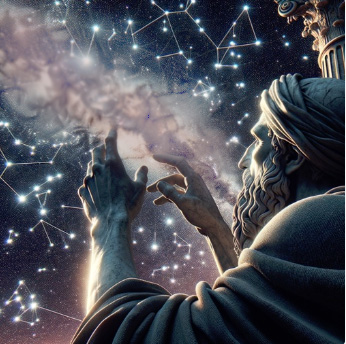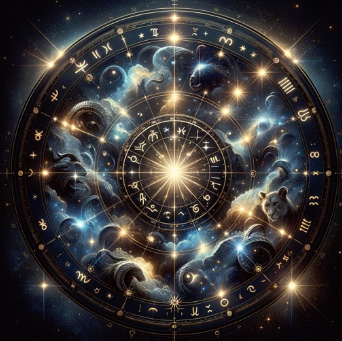The Difference Between Astronomy and Astrology
 I'm not going to assert that belief in astrology is right or wrong. Everyone has their own truth and their own reality, and it's important to respect that. Shamanic Astrology (which has nothing to do with newspaper horoscopes) has a long and respectable history. What I would like to explain is why astronomers have such a difficult time with astrology.
I'm not going to assert that belief in astrology is right or wrong. Everyone has their own truth and their own reality, and it's important to respect that. Shamanic Astrology (which has nothing to do with newspaper horoscopes) has a long and respectable history. What I would like to explain is why astronomers have such a difficult time with astrology.
A little History: Astronomy and astrology were the same thing before the modern era, because predictive and divinatory knowledge was one of the motivating factors for astronomical observation. Astronomy is simply the observation and measurement of celestial bodies, while astrology is an attempt to find some sort of "meaning" or "influence" in the planetary positions. The interesting thing is that astrology gave birth to astronomy. Oddly enough, considering that astrology has to do with planetary movements, astrologers no longer look at the sky, and haven't for hundreds of years.
Modern astronomers find it difficult to connect with astrology because the data used by astrologers bears no relation to what is actually seen in the sky. Astrologers have ignored the slow "wobble" of the earth on it's axis, called the precession of the equinoxes, even though Hipparchus discovered it as long ago as 100 BC. It means that the position of the ecliptic in the sky has shifted quite a bit in the last two thousand years, so that the zodiac is not the same as it was in the year 0.
As an example, I'm always told that I'm a Cancer, since I was born in July, because the sun is in Cancer in July. Well, the sun was in Cancer 2000 years ago, but in the year I was born the sun was in Gemini, not Cancer. Anyone with a simple astronomy or planetarium program on their computer can input the year and day they were born and see for themselves what "sign" they were born under. I use Starry Night.
|
By the way, the plane of the earth's ecliptic now crosses the constellation Ophiuchus (it didn't 2000 years ago) so there are currently 13 zodiacal constellations in the northern hemisphere, not 12. Go to a bookstore and look at any star chart that shows the ecliptic and you will see it soaring happily through Ophiuchus! Some astrologers have suggested that the borders of the constellations are too wide. If we narrow the borders, then the constellation that gets excluded is Scorpius, not Ophiuchus. Here's a chart showing how many days the sun spends in each constellation: |
| Even the Ancient Mayans had a Zodiac with 13 Constellations, as did the Babylonians.The ancient Mayan zodiac was composed of 13 constellations, including the constellation Ophiuchus, which is exactly what is seen in the sky today. The description of the 13 constellations of the Mayan zodiac is found in The Paris Codex, (Codex Peresianus), one of the very few texts of the pre-Conquest Maya that survived the book burnings by the Spanish clergy during the 16th century. As everyone by now knows, the Mayans were famous for their precise astronomical observations and their accurate predictions of eclipses and of Venus rising. The ancient Babylonians originally started out with 13 constellations that the sun appeared to pass through. But in order to make their zodiac fit within their 12-month calendar (based on the lunar cycle), one of the constellations had to be left out. So Ophiuchus got the ax. |
The signs of the zodic were more or less aligned with their corresponding constellations about 2,000 years ago. But in the intervening centuries, the slow wobble of the Earth’s axis has caused the solstice and equinox points to shift roughly 30 degrees westward relative to the constellations! At present, the signs and constellations are about one calendar month off. In another two thousand years or so, they’ll be about two months off. Astrologers pay no attention to what is actually seen in the sky. Their predictions are based on ancient shamanic lore and have more to do with the idea of a collective consciousness, history and story-telling than physical reality.
Also, astrologers consider retrograde motion to be an important influence on their lives. In astrology, this backward movement was traditionally thought to be unlucky or inauspicious, as it went against the 'natural' order of movement. The problem is, retrograde motion is purely an optical illusion, caused by the line of sight when looking at an outer planet that is being overtaken by a faster-moving, inner planet. (There are many animated, graphic demonstrations of this on the internet). Astronomers (and many other people) have trouble believing that any part of their lives can be influenced by an optical illusion.
Retrograde Motion Made SimpleHave you ever been in a fast train that overtook another train on the next track, traveling in the same direction as your train? Through the window, the slower train looks like it’s moving backwards, even though it’s traveling in the same direction. This is exactly what happens when the earth catches up to another planet in a more distant orbit. As the earth passes the other planet at a higher speed, the other planet appears to be moving backwards. Like the train, it is not moving backwards. It’s purely an optical illusion. Since the time of Copernicus, astronomers have called this “retrograde motion,” understanding that it’s an illusion. Naturally, it’s difficult for astronomers to believe that an optical illusion can have an effect on you in any way.
|
In Defense of Astrologers
 Leading astrological proponents defend astrology by explaining that Western astrology strictly adheres to the tropical zodiac, which is fixed to seasons, not to the stars. They claim that sidereal zodiac, observed in the Far East, is the one affixed to constellations and is not of use to astrologers. They insist that the tropical zodiac has been in place since the Egyptican astronomer Ptolemy in the second century.
Leading astrological proponents defend astrology by explaining that Western astrology strictly adheres to the tropical zodiac, which is fixed to seasons, not to the stars. They claim that sidereal zodiac, observed in the Far East, is the one affixed to constellations and is not of use to astrologers. They insist that the tropical zodiac has been in place since the Egyptican astronomer Ptolemy in the second century.
The tropical zodiac computes the sun in 1 of 12 zones around the earth. Each of the 12 has an angular length of 30°. 12 X 30° = 360°. The frame of reference for these zones is the sun’s position relative to the earth’s horizon. None of these signs are related to the group of stars that can be seen in the skies with one's physical eyes. In other words, it has nothing to do with reality, just an arbitrary division of the sky into 12 zones.
Why is it important to have 12 zones? Babylonian astrology was the first organized system of astrology, arising in the second millennium BC. At that time, they were working with a calendar that was divided into 12 months. 13 constellations did not fit into that calendar, so they simply discarded the constellation Ophiuchus. The ancient Sumerian calendar divided a year into 12 lunar months of 29 or 30 days. Each month began with the sighting of a new moon. Thus, their astrology was arrived at by dividing the sky into twelve constellations with a measurement of 30° to each division.
Leading astrological proponents also correctly point out that newspaper horoscopes and popular astrology magazines have little to do with serious tropical or Shamanic astrology, and that casting your horoscope is much more complicated than typing your date and place of birth into a website, that it takes into account many different bits of data that must be precisely entered into the calculation. It is beyond belief that one-twelfth of the world’s population is having the same kind of day. But serious Shamanic astrologers do not subscribe to such simplified notions.
 Shamanic Astrology is ceremonial and participatory, and operates from a mythic perspective. Shamanic cultures around the world tell us that authentic shamanic ceremonies are mythic re-enactments of cosmological events. Over time, the cultural ceremonies and mythic stories created by the various civilizations are draped onto the actual physically observed cycles of the planets and patterns of the constellations. These become symbolic, archetypal energies and have no relationship with what modern astronomers see in the sky. Rather, they are based on what shamans and astrologers (often the same person) have observed for thousand of years. Shamanic Astrology links to modern psychology through the use of archetypes. It values the totality of the human experience with all its gold and shadow. The practitioner of Shamanic Astrology is trained in a thorough and comprehensive non-hierarchical view of archetypal possibilities. The Shamanic astrologer seeks an understanding of the dynamic forces at work in human affairs. It's a metaphysical toolkit for managing the deepest and most profound differences in people. By achieving greater insight into our psyche, any bright, curious human being can, quite simply, begin to change the world. |
